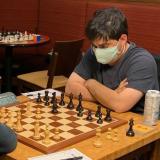Hello everyone!
I am a life-long chess enthusiast who focuses less on hack and slash attacking chess and more on the beauty of strategy and maneuvering. Although I think good calculation is important, I am a firm believer that the key to high-level play is to encode thinking into chess "language" and to have a large toolkit of strategic concepts (from generalized concepts to opening/endgame specific ones) from which to draw upon when making decisions.
To understand my approach, I like to give the following example. Try to imagine that you no longer have the ability to speak any language. How complex do you think your thoughts would be? I contend that you would be able to do little more than to imagine basic needs such as hunger or thirst; you certainly wouldn't be able to think about philosophy, for example. Chess is the same way. Studies have shown that Grandmasters don't calculate or consider significantly more moves than beginners. Instead they rely on a huge toolkit of knowledge to prune out bad moves from consideration right from the start.
For example, take the following position:
A beginner would likely think about piece placement and development, but not really have much of a plan. A stronger player, on the other hand, would look at the position and think the following:
1. This is a Carlsbad pawn structure, which means that White really only has two viable plans. Given my style of play, I will play for the more traditional plan, which is the minority attack instead of the more modern f3-e4 expansion plan [a minority attack is one in which the side with a pawn minority on one wing (White, who only has the a and b pawns to Black's a-b-c pawns), launches them forward with the purpose of trading one off and creating a weakness in Black's camp].
2. In order to play a minority attack, I will need to launch my a and b pawn forward together and try to engage black on c6, hopefully provoking the trade bxc6 and then pressuring the backwards c pawn.
3. Given the plan articulated above, the most logical moves to consider are either a4, b4, or Rb1 (supporting the b-pawn). I should also consider what Black wants to do, and add any move to consideration that might hamper his plans. Here, Black might want to trade off his bad c8-bishop by playing Bg4. I should therefore also consider whether to play h3. Finally, when considering a4 vs. b4, I need to keep in mind that I might need to play Na4 to prevent Black from pushing his c-pawn to c5 if I play b4-b5.
If my approach appeals to you, feel free to reach out. Teaching chess is not my day job, and I only do it out of love for the game. I charge $40 dollars an hour for individual lessons, but I am open to other arrangements, like group lessons or training games. Thanks!





